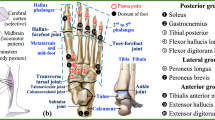Abstract
Telerehabilitation is an emerging field of rehabilitation. Combining medicine and engineering, telerehabilitation provides an alternative method of rehabilitation therapy in areas lacking medical resources, and an easy way to resolve the inconvenience for the disabled patients to seek rehabilitation services. This study developed a device that integrates inertial measurement units (IMU) and an ankle foot orthosis (AFO) named AFO-IMU module. We further demonstrate the AFO-IMU module on telerehabilitation diagnostic including patients with muscle weakness due to brain injuries and patients who will receive total knee replacement surgery due to osteoarthritis of knee joints to determine the feasibility in clinical usage. The results from this study indicate that AFO-IMU module is a simple and effective telerehabilitation system to correctly assess knee joint activity and track knee joint rehabilitation diagnosis.






Similar content being viewed by others
References
Aminian K, Najafi B, Büla C, Leyvraz P-F, Robert P (2002) Spatio-temporal parameters of gait measured by an ambulatory system using miniature gyroscopes. J Biomech 35(5):689–699
Bourke AK, Lyons GM (2008) A threshold-based fall-detection algorithm using a bi-axial gyroscope sensor. Med Eng Phys 30(1):84–90
Burdea GC (2003) Virtual rehabilitation–benefits and challenges. Methods Inf Med 42(5):519–523
Burdea G, Popescu V, Hentz V, Colbert K (2000) Virtual reality-based orthopedic telerehabilitation. IEEE Trans Rehabil Eng 8(3):430–432
Buurke JH, Nene AV, Kwakkel G, Erren-Wolters V, Ijzerman MJ, Hermens HJ (2008) Recovery of gait after stroke: what changes? Neurorehabil Neural Repair 22(6):676–683
Chiu KY, Ng TP, Tang WM, Yau WP (2002) Review article: knee flexion after total knee arthroplasty. J Orthop Surg (Hong Kong) 10(2):194–202
Coley B, Najafi B, Paraschiv-Ionescu A, Aminian K (2005) Stair climbing detection during daily physical activity using a miniature gyroscope. Gait Posture 22(4):287–294
Cooper G, Sheret I, McMillan L, McMillian L, Siliverdis K, Sha N, Hodgins D, Kenney L, Howard D (2009) Inertial sensor-based knee flexion/extension angle estimation. J Biomech 42(16):2678–2685
Deutsch JE, Lewis JA, Burdea G (2007) Technical and patient performance using a virtual reality-integrated telerehabilitation system: preliminary finding. IEEE Trans Neural Syst Rehabil Eng 15(1):30–35
Durfee W, Carey J, Nuckley D, Deng J (2009) Design and implementation of a home stroke telerehabilitation system. Conf Proc IEEE Eng Med Biol Soc 2009:2422–2425
Gowland C, Stratford P, Ward M, Moreland J, Torresin W, Van Hullenaar S, Sanford J, Barreca S, Vanspall B, Plews N (1993) Measuring physical impairment and disability with the Chedoke-McMaster stroke assessment. Stroke 24(1):58–63
Henderson A, Korner-Bitensky N, Levin M (2007) Virtual reality in stroke rehabilitation: a systematic review of its effectiveness for upper limb motor recovery. Top Stroke Rehabil 14(2):52–61
Holden MK, Dyar TA, Dayan-Cimadoro L (2007) Telerehabilitation using a virtual environment improves upper extremity function in patients with stroke. IEEE Trans Neural Syst Rehabil Eng 15(1):36–42
Krebs HI, Hogan N, Aisen ML, Volpe BT (1998) Robot-aided neurorehabilitation. IEEE Trans Rehabil Eng 6(1):75–87
Liu K, Liu T, Shibata K, Inoue Y, Zheng R (2009) Novel approach to ambulatory assessment of human segmental orientation on a wearable sensor system. J Biomech 42(16):2747–2752
Masouros SD, Bull AMJ, Amis AA (2010) Biomechanics of the knee joint. Orthop Trauma 24(2):84–91
McGinty G, Irrgang JJ, Pezzullo D (2000) Biomechanical considerations for rehabilitation of the knee. Clin Biomech 15(3):160–166
Miyazaki S (1997) Long-term unrestrained measurement of stride length and walking velocity utilizing a piezoelectric gyroscope. IEEE Trans Biomed Eng 44(8):753–759
Nyan MN, Tay FEH, Tan AWY, Seah KHW (2006) Distinguishing fall activities from normal activities by angular rate characteristics and high-speed camera characterization. Med Eng Phys 28(8):842–849
Saposnik G, Levin M (2011) Virtual reality in stroke rehabilitation: a meta-analysis and implications for clinicians. Stroke 42(5):1380–1386
Zhou H, Hu H (2008) Human motion tracking for rehabilitation—a survey. Biomed Signal Process Control 3(1):1–18
Acknowledgments
Authors would like thank to Cathay General Hospital (Grant #CGH-MR-10111) and National Science Council, Taiwan (Grant #NSC 102-2221-E-008-041) financial support this project.
Author information
Authors and Affiliations
Corresponding author
Rights and permissions
About this article
Cite this article
Han, SL., Xie, MJ., Chien, CC. et al. Using MEMS-based inertial sensor with ankle foot orthosis for telerehabilitation and its clinical evaluation in brain injuries and total knee replacement patients. Microsyst Technol 22, 625–634 (2016). https://doi.org/10.1007/s00542-015-2439-1
Received:
Accepted:
Published:
Issue Date:
DOI: https://doi.org/10.1007/s00542-015-2439-1




